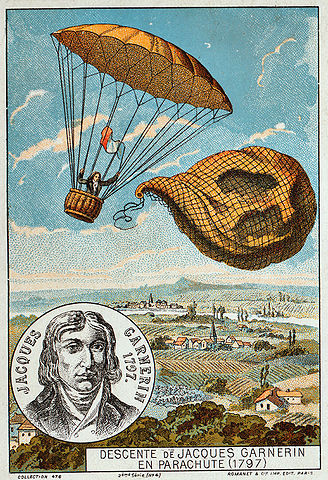*Image Credit: Wikimedia Commons After floating more than 3,000 feet above the streets of Paris, balloonist Andre-Jacques Garnerin changed aviation forever by taking a startling risk on October 22, 1797: he cut the hydrogen balloon supporting his flight loose and dropped to Earth. Testing his idea for an umbrella-shaped parachute, Garnerin landed safely in the Parc Monceau under the 30-foot-wide silk canopy which had prevented him from falling like a rock. Being a daredevil would soon be part of the family business. Garnerin had grown up in Paris, becoming intimately familiar with the work of Jacques Charles, the man who had launched a hydrogen-filled balloon into the skies above the French capital with brothers Anne-Jean and Nicolas-Louis Robert in the summer of 1783. By December of that year, Charles joined the latter in the world’s first manned hydrogen balloon flight. In 1787, at the age of just 18, Garnerin made his first ascent just outside of Metz. In the midst of the French revolution, as the nation heaved back and forth while facing down the challenges of the First Coalition, Garnerin was captured by the British and turned over to the Austrians. A prisoner of war for two years, he later claimed he conceived of the idea for a parachute as a means of escaping the jail in Buda, Hungary that had been his home. The design, an umbrella-like stretch of fabric with a central pole to hold its 36 spokes, would be suspended below an inflated hydrogen balloon. Returning to Paris after his captivity, Garnerin connected with his brother Jean-Baptiste-Olivier to conduct a series of public “ballooning experiments.” Hoping to treat them as spectacles — Parisians were accustomed to seeing balloonists rise above the city from various parks — Garnerin believed he could bring his craft down safely after launching from the Byron Hotel on June 15, 1797. High winds damaged the fabric of his balloon, however, forcing him to escape a rioting audience by floating over the top of them without deploying his invention — and later facing the police under charges of misrepresenting themselves. Though it took a further four months, Garnerin managed a successful take-off on October 22, 1797. Rising above onlookers at the Parc Monceau in northwestern Paris, he achieved an altitude in excess of 3,000 feet before cutting the balloon loose. As the basket entered a freefall, the silk parachute opened just as planned, slowing Garnerin’s descent. The mesmerized crowd watched as the craft swayed violently in the wind. Without the benefit of vents at the center of the canopy, the parachute was more susceptible to gusts of air, leaving Garnerin to bounce wildly back and forth. (According to legend, he had issues with motion sickness and vomited on the people below.) When the basket tumbled into the ground, he had sustained no injuries. In the years to come, Garnerin would continue performing daring feats, experimenting with his parachutes and even making his wife the first female balloonist in history. His niece, taking up the baton, would go on to complete a number of successful descents on her own. For his work elevating French science, Garnerin would later be named the nation’s Official Aeronaut. Also On This Day: 794 – Emperor Kanmu of Japan moves the capital to Heiankyo, modern Kyoto 1633 – The Ming Navy defeats the Dutch East India Company in the Battle of Liaoluo Bay 1879 – Thomas Edison tests the first practical electric incandescent electric light bulb 1946 – Soviet officials launch Operation Osoaviakhim, luring German specialists from the V-2 rocket programs and others to work for the Soviet Union 1962 – United States President John F. Kennedy announces the discovery of Soviet missiles in Cuba and subsequent “quarantine” of the island nation
October 22 1797 CE – Andre-Jacques Garnerin Becomes the First Parachutist
*Image Credit: Wikimedia Commons After floating more than 3,000 feet above the streets of Paris, balloonist Andre-Jacques Garnerin changed aviation forever by taking a startling risk on October 22, 1797:…
335
